

Génération de terrain par l'algorithme de Perlin. Vous voulez créer un jeu, il vous faut un terrain, plusieurs solutions s'offrent à vous : le dessiner à la main une fois pour toute ou bien le faire générer par votre programme.
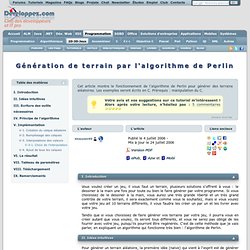
Si vous choisissez de le dessiner à la main, vous aurez une très grande liberté et un très grand contrôle de votre terrain, il sera exactement comme vous le souhaitez, mais si vous voulez que votre jeu ait 10 terrains différents, il vous faudra les créer un par un et les livrer avec votre jeu. Tandis que si vous choisissez de faire générer vos terrains par votre jeu, il pourra vous en créer autant que vous voulez, ils seront tous différents, et vous ne serez pas obligé de les fournir avec votre jeu, puisqu'ils pourront être regénérés.
C'est de cette méthode que je vais parler, en expliquant un algorithme qui fonctionne très bien : l'algorithme de Perlin. Pour générer un terrain aléatoire, la première idée (naïve) qui vient à l'esprit est de générer une hauteur aléatoire pour chaque position du terrain. V-1. V-2. Perlin Noise. Many people have used random number generators in their programs to create unpredictability, make the motion and behavior of objects appear more natural, or generate textures.
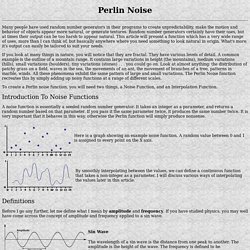
Random number generators certainly have their uses, but at times their output can be too harsh to appear natural. This article will present a function which has a very wide range of uses, more than I can think of, but basically anywhere where you need something to look natural in origin. What's more it's output can easily be tailored to suit your needs. If you look at many things in nature, you will notice that they are fractal. They have various levels of detail. Randomly generated world map · Kaelan Cooter. When I first started designing a Sci-fi browser strategy game, I knew I wanted it to be grand in scope.
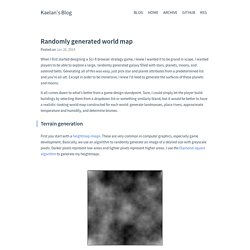
I wanted players to be able to explore a large, randomly generated galaxy filled with stars, planets, moons, and asteroid belts. Generating all of this was easy, just pick star and planet attributes from a predetermined list and you’re all set. Except in order to be immersive, I knew I’d need to generate the surfaces of these planets and moons. It all comes down to what’s better from a game design standpoint.
Sure, I could simply let the player build buildings by selecting them from a dropdown list or something similarly bland, but it would be better to have a realistic-looking world map constructed for each world: generate landmasses, place rivers, approximate temperature and humidity, and determine biomes. Terrain generation First you start with a heightmap image. A typical Heightmap image Next we determine a sea level. Rivers. ThingOnItsOwn. Master of Magic Part #75 - Map Generation and Neutral Towns. Part 75: Map Generation and Neutral Towns nweismuller posted: Neutral cities get to 'cheat' a bit on food support for their troops.
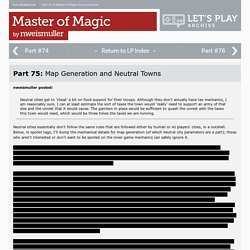
Although they don't actually have tax mechanics, I am reasonably sure, I can at least estimate the sort of taxes the town would 'really' need to support an army of that size and the unrest that it would cause. The garrison in place would be sufficient to quash the unrest with the taxes this town would need, which would be three times the taxes we are running. Neutral cities essentially don't follow the same rules that are followed either by human or AI players' cities, in a nutshell. Both planes have a map that is 60 squares wide and 40 squares high.
Once the base map is generated, terrain features are then placed. The game then places exactly 6 Towers of Wizardry on each plane, which will share identical X/Y coordinates on each plane. Next, the game places 16 nodes on Arcanus and 14 on Myrror, the type of which is determined by the surrounding terrain. Twenty Sided. Civ1 Map Generation explained. Ben Hallett. This is a brief, incomplete list of projects that I have worked on in my spare time, mostly for my own edification and amusement.

The source code for most of them is visible in my various GitHub repositories. World Generator World generator is a Unity project I made partly to learn about how the Unity Terrain asset works, but also to experiment with procedural terrain generation techniques. It randomly generates continents, surrounded by ocean and divided up into biomes. Here are some examples: Controls WASD or Arrow keys Move the camera around. Middle mouse button While the button is held down, rotate the camera with the mouse, like in an FPS.
Scroll wheel Zoom in/out. Esc Quit. The terrain is randomly generated when you first load the application, but if you don't like what you see or become bored of exploring one world, you can click the "Regenerate" button in the top left to generate a new world. The "Minimap" below the Regenerate button cycles between three modes: Heightmap Rainmap. FANDOM powered by Wikia. In most cases, the map will be cylindrical with wraparound on an east-west axis, with impassible ice caps at the northern and southern edges.
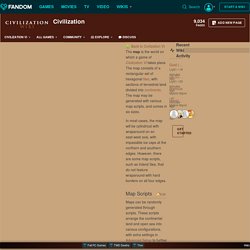
Biomes. Name from Finnish term meaning "a treeless plain".
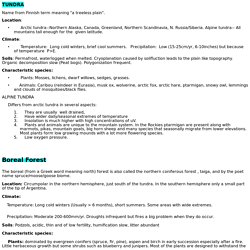
Location: